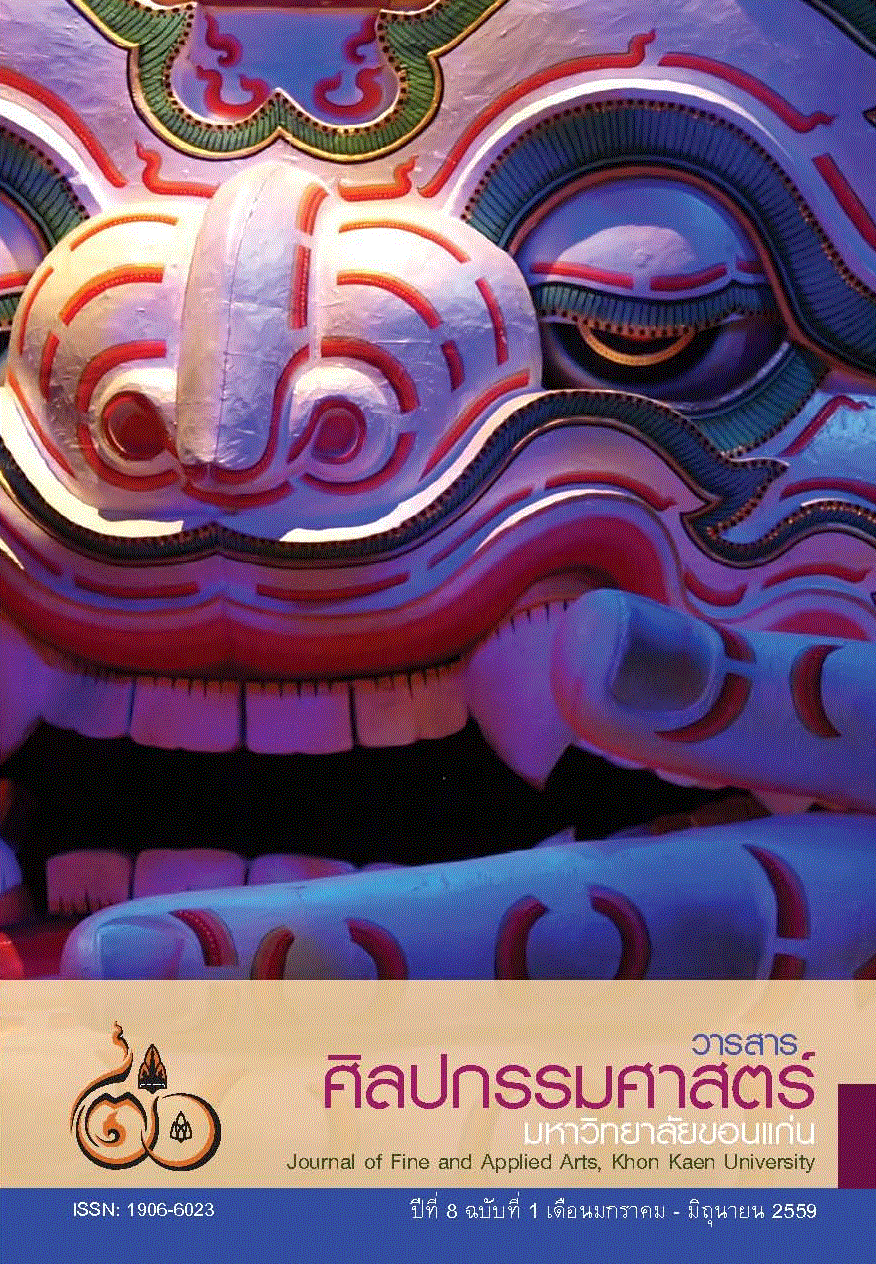จิตรกรรมฝาผนังพื้นถิ่น : ศรัทธาและความเชื่อจากรูปแบบศิลปะพระพุทธเจา ทรงเครื่องเรื่องพระพุทธประวัติ1 Local mural painting: Faith and beliefs from styles of crowned Buddha Image in Life of the Buddha
Main Article Content
Abstract
ภาพจิตรกรรมพื้นถิ่นในแถบอีสานตอนกลางนั้น มีอายุการสรางอยูในชวง ราวกลาง -ปลายพุทธศตวรรษที่ 25 หรือราวรัชสมัยรัชกาลที่ 5 แหงกรุงรัตนโกสินทร แนวคิดหรือแรงบันดาลใจในการสรางงานจิตรกรรมฝาผนังที่แสดงลักษณะเฉพาะ ของชางพื้นถิ่นไดนํามาจากวรรณกรรมพื้นถิ่นที่อางอิงการคัดลอกมาจากตนฉบับของ ประเทศลาว เนื้อหาพุทธประวัติบางสวนบางตอนที่เปนรายละเอียดจึงสะทอนรูป แบบศิลปะตางไปจากจิตรกรรมทางภาคกลาง ภาพพระพุทธรูปทรงเครื่องในงานจิตรกรรมฝาผนังพื้นถิ่นหรือ “ฮูป แตม”ในเขตอีสานตอนกลางเรื่องพุทธประวัติ มักปรากฏรูปแบบเขียนไวในตอนหลัง จากที่พระพุทธเจาทรงเสด็จออกผนวชแลว เชน ตอนมารผจญ ตอนเสด็จปรินิพาน ดวยรูปแบบศิลปะการทรงเครื่องที่เนนเฉพาะการสวมมงกฏเปนสําคัญ ประทับนั่ง ทั้งปางสมาธิและปางมารวิชัย สองลักษณะที่ไดอ ธิบายไว ไมวาจะเปนรูปแบบศิลปะ ที่อิงจิตรกรรมไทยประเพณี หรือรูปแบบที่คลี่คลายเปนพื้นถิ่น หากแตรูปแบบทั้ง สองนี้ ชางพื้นถิ่นไดยึดถือเปนแนวปฏิบัติกัน จนพบความนิยมแพรหลายในสิมหลาย แหลง รูปแบบการทรงเครื่องดังกลาวอาจสอดคลองเชื่อมโยงไปถึงหลักฐานกลุมงาน พระพุทธรูปพื้นบาน ระหวางปลายพุทธศตวรรษที่ 24-25 กลุมพระแกวมรกตจําลอง ที่ซึ่งมีคติแนวคิดสําคัญในการจําลองพระแกวมรกตที่เคยเปนพระพุทธรูปศักดิ์สิทธิ คูบานคูเมืองของชาวลาว โดยการจําลองเปนพระพุทธรูปขนาดเล็กอยางแพรหลาย ในภาคอีสาน ดังนั้นเปนไปไดที่ความเชื่อ ความศรัทธาและความระลึกถึงพระแกว มรกตนี้ยังคงตกทอดมาสูผูคนพื้นที่อีสานตอนกลางที่มีความสัมพันธทางดานเชื้อชาติ กับคนลาวในชวงพุทธศตวรรษที่ 25 นี้ดวย แตหากถายทอดความศรัทธานี้ลงสูรูป แบบของงานจิตรกรรมฝาผนัง
Local mural paintings in middle Isan are dated around mid-late B.D. 25 or during the reign of King Rama V of Rattanakosin period. The concepts and inspirations of mural painting that showed the unique of local artist might come from local literatures that copied from its original in Laos. Some parts of Life of the Buddha story here therefore are different from details of mural painting in Central Thailand. The crowned Buddha in local mural painting or “Hoop Tam” in middle Isan always appearedin scenes after the ordination of the Buddha, for example, a scene of Buddha Subduing Mara or a scene of the Death of the Buddha. Thesecrowned Buddha Images wears only head dress or crown without any other royal attires and can be found in subduing mara position and meditating position and also foundin both Thai tradition and local mural painting. These two styles are popular among local artists as they are found in many Sim. The style of crowned Buddha image may relate to group of Buddha Image late B.D. 24-25. The concept of this group was to replicate the Emerald Buddha which at that time was an important Buddha Image of Laos. These Buddha Images have been replicated in small size and were popular in Isan. It is possible that those belief, faith and remembrance have been passed on to people in middle Isan who have race relation with Laos people during B.D 25 but showed their beliefs through mural painting instead.
Article Details
Content and information in articles published in the Journal of Fine and Applied Arts of Khon Kaen University is regarded as the opinion and sole responsibility of the author(s) directly; therefore, editors are not obliged to agree to or share any responsibility with regard to the content and information that appears within these articles.
All articles, information, content, image, etc. that have been published in the Journal of Fine and Applied Arts of Khon Kaen University is the copyright of the Journal of Fine and Appllied Arts of Khon Kaen University. Any person or organization who wishes to distribute all or parts of the articles for further dissemination or other usage must first receive permission from the Journal of Fine and Applied Arts of Khon Kaen University before proceeding to do so.


